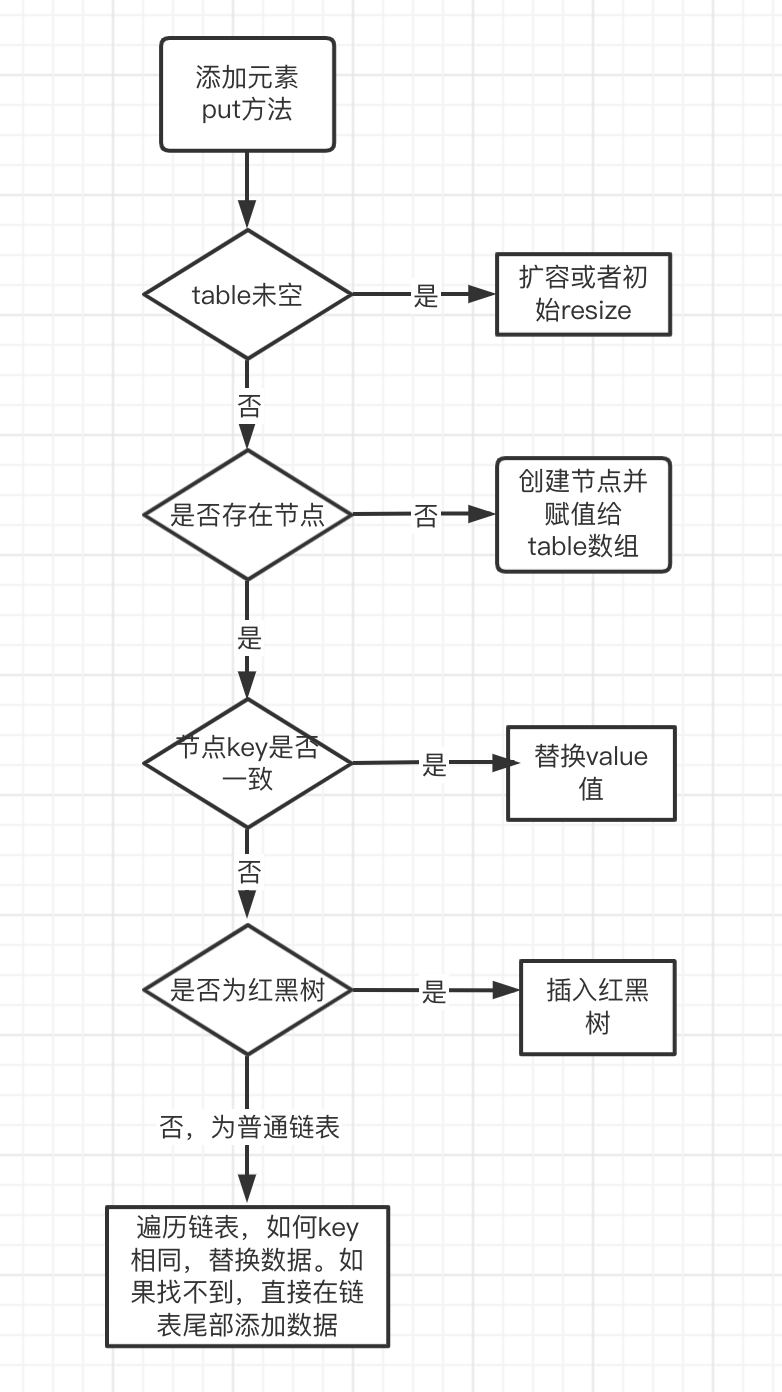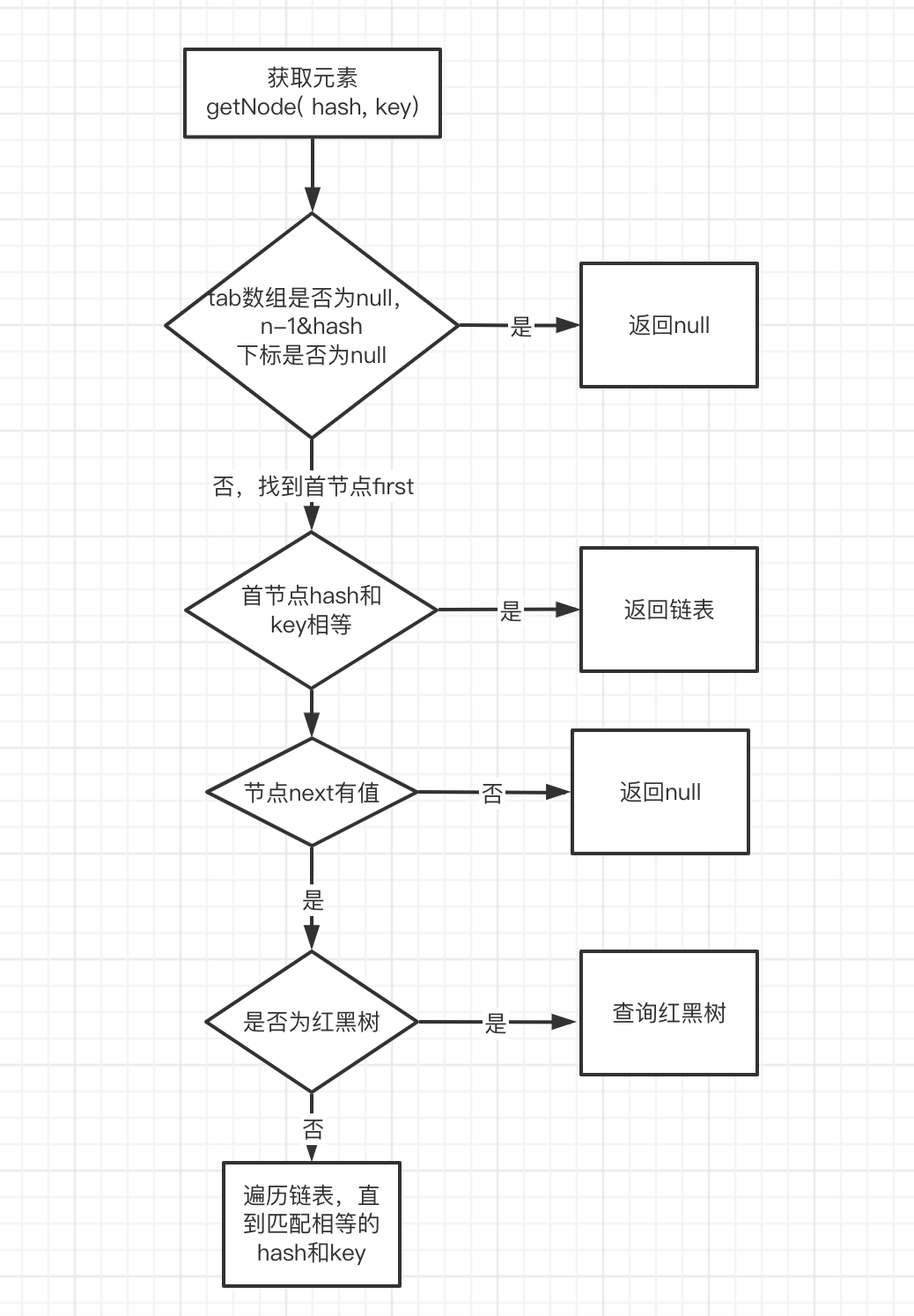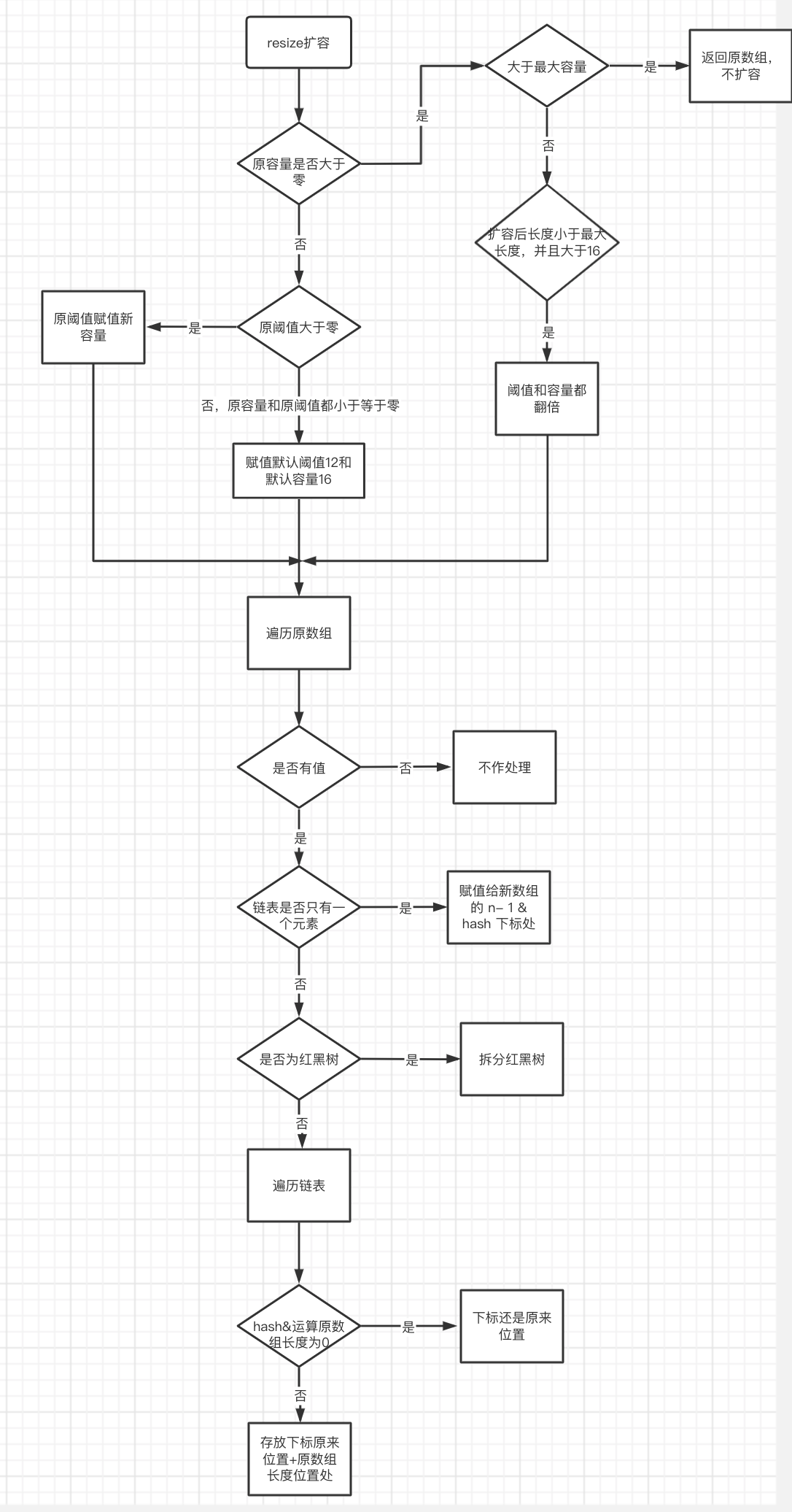上文详解HashMap源码解析(上)介绍了 HashMap 整体介绍了一下数据结构,主要属性字段,获取数组的索引下标,以及几个构造方法。本文重点讲解元素的 添加 、 查找 、 扩容 等主要方法
添加元素 put(K key, V value)上文详解HashMap源码解析(上)介绍了
HashMap整体介绍了一下数据结构,主要属性字段,获取数组的索引下标,以及几个构造方法。本文重点讲解元素的添加、查找、扩容等主要方法。
public V put(K key, V value) {
return putVal(hash(key), key, value, false, true);
}
首先算出key的哈希码,调用hash方法,获取到hash值。
- 调用putVal()
/**
* @param hash hash for key hash 值
* @param key the key key 值
* @param value the value to put value 值
* @param onlyIfAbsent if true, don't change existing value 只有不存在,才不改变他的值
* @param evict if false, the table is in creation mode.
* @return previous value, or null if none 返回上一个值,如果不存在返回null
*/
final V putVal(int hash, K key, V value, boolean onlyIfAbsent,
boolean evict) {
// 声明一个node数组 tab,node 节点
Node<K,V>[] tab; Node<K,V> p; int n, i;
// 如果 table 为 null 或者 tab的长度为 0 ,|| 两边都要做一下判断,table 为空,或者table的长度为0
if ((tab = table) == null || (n = tab.length) == 0)
// table 初始化
n = (tab = resize()).length;
// 不存在,直接新建一个Node节点
if ((p = tab[i = (n - 1) & hash]) == null)
// 新建节点
tab[i] = newNode(hash, key, value, null);
else {
// 存在节点
Node<K,V> e; K k;
// hash值 和 p 节点的hash值一致,(键值的地址)一致或者(键的值)一致,直接替换
if (p.hash == hash &&
((k = p.key) == key || (key != null && key.equals(k))))
e = p;
// 节点是红黑树
else if (p instanceof TreeNode)
e = ((TreeNode<K,V>)p).putTreeVal(this, tab, hash, key, value);
else {
// 节点是链表,从前往后遍历
for (int binCount = 0; ; ++binCount) {
// 遍历链表的最后一个节点
if ((e = p.next) == null) {
p.next = newNode(hash, key, value, null);
// 链表个数大于等于 8,因为从零开始所以要减一
if (binCount >= TREEIFY_THRESHOLD - 1) // -1 for 1st
// 转成红黑树
treeifyBin(tab, hash);
break;
}
// hash一致 或者 值一致
if (e.hash == hash &&
((k = e.key) == key || (key != null && key.equals(k))))
break;
p = e;
}
}
// e不为空,直接替换赋值
if (e != null) { // existing mapping for key
V oldValue = e.value;
if (!onlyIfAbsent || oldValue == null)
// 原来的值为空,赋值
e.value = value;
afterNodeAccess(e);
return oldValue;
}
}
++modCount;
if (++size > threshold)
resize();
afterNodeInsertion(evict);
return null;
}
- 首先判断哈希数组
table是否为null,如果为null,就扩容。 (n - 1) & hash对应的下标是否存在节点。- 不存在节点,就创建新的节点并赋值。
- 存在节点
- 节点key值是否相等,相等就替换
value。 - 是否为红黑树,添加数据到红黑树中。
- 上面都不符合,就是普通链表,遍历链表,如果链表存在相同
key就替换,否则在链表最后添加数据。
- 节点key值是否相等,相等就替换
流程图:

putAll 是将集合元素全部添加到HashMap中,putAll调用了putMapEntries方法,putMapEntries先判断是否需要扩容,然后遍历元素,调用putVal添加元素,下面是添加元素代码:
for (Map.Entry<? extends K, ? extends V> e : m.entrySet()) {
K key = e.getKey();
V value = e.getValue();
putVal(hash(key), key, value, false, evict);
}
通过key找到哈希表的中Node节点的value值。
// 返回map映射对应的value值
public V get(Object key) {
Node<K,V> e;
return (e = getNode(hash(key), key)) == null ? null : e.value;
}
首先使用hash方法算出哈希值,然后再调用getNode()获取数据:
final Node<K,V> getNode(int hash, Object key) {
Node<K,V>[] tab; Node<K,V> first, e; int n; K k;
// 判断tab有数据,并且对应下标存在数据
if ((tab = table) != null && (n = tab.length) > 0 &&
(first = tab[(n - 1) & hash]) != null) {
// hash相等以及key相等(key地址相等或者key的值相等),找的就是第一个元素
if (first.hash == hash && // always check first node
((k = first.key) == key || (key != null && key.equals(k))))
return first;
// 遍历链表
if ((e = first.next) != null) {
// 红黑树找到当前key所在的节点位置
if (first instanceof TreeNode)
return ((TreeNode<K,V>)first).getTreeNode(hash, key);
do {
// 普通链表,往后遍历,直到找到数据或者遍历到链表末尾为止
if (e.hash == hash &&
((k = e.key) == key || (key != null && key.equals(k))))
return e;
} while ((e = e.next) != null);
}
}
return null;
}
- 判断哈希数组是否不为
null并且数组下标(n - 1) & hash处不为null,如果都有值,就查询首节点first,否则返回null。 - 找到首节点,匹配上相等的
hash和key,返回首节点。 - 链表有多个元素,是否为红黑树
- 是红黑树,在红黑树查找
- 不是红黑树,就遍历普通链表,直到匹配到相同的
hash和key值。
流程图:

当哈希数组为null,或元素个数超过了阈值,就调用resize扩容方法:
final Node<K,V>[] resize() {
// 记录原数组
Node<K,V>[] oldTab = table;
// 原数组长度
int oldCap = (oldTab == null) ? 0 : oldTab.length;
// 原阈值(数组长度达到阈值)
int oldThr = threshold;
// 新容量,新阈值
int newCap, newThr = 0;
if (oldCap > 0) {
// 数组长度大于或者等于MAXIMUM_CAPACITY(1>>30)不做扩容操作。
if (oldCap >= MAXIMUM_CAPACITY) {
threshold = Integer.MAX_VALUE;
return oldTab;
}
// 扩容后长度小于MAXIMUM_CAPACITY(1>>30)并且数组原来长度大于16
// 阈值和新容量都翻倍
else if ((newCap = oldCap << 1) < MAXIMUM_CAPACITY &&
oldCap >= DEFAULT_INITIAL_CAPACITY)
newThr = oldThr << 1; // double threshold
}
// 阈值大于零,旧阈值替换成新容量
else if (oldThr > 0) // initial capacity was placed in threshold
newCap = oldThr;
else { // zero initial threshold signifies using defaults
// oldCap 和 oldThr 都小于等于0,说明是调用无参构造方法,赋值默认容量16,默认阈值12。
newCap = DEFAULT_INITIAL_CAPACITY;
newThr = (int)(DEFAULT_LOAD_FACTOR * DEFAULT_INITIAL_CAPACITY);
}
if (newThr == 0) {
// 新阈值为零,计算阈值
float ft = (float)newCap * loadFactor;
newThr = (newCap < MAXIMUM_CAPACITY && ft < (float)MAXIMUM_CAPACITY ?
(int)ft : Integer.MAX_VALUE);
}
threshold = newThr;
@SuppressWarnings({"rawtypes","unchecked"})
// 新建Node数组。调用无参构造方法,并不会创建数组,在第一次调用put方法,才会调用resize方法,才会创建数组,延迟加载,提高效率。
Node<K,V>[] newTab = (Node<K,V>[])new Node[newCap];
table = newTab;
// 原来的数组不为空,把原来的数组的元素重新分配到新的数组中
// 如果是第一次调用resize方法,就不需要重新分配数组。
if (oldTab != null) {
// 旧数组遍历
for (int j = 0; j < oldCap; ++j) {
Node<K,V> e;
// 存在下标下的第一个元素
if ((e = oldTab[j]) != null) {
oldTab[j] = null;
// 当前元素下一个元素为空,说明此处只有一个元素,直接使用元素的hash值和新数组的容量取模,获得新下标的位置
if (e.next == null)
newTab[e.hash & (newCap - 1)] = e;
// 红黑树,拆分红黑树,必要时可能退化为链表
else if (e instanceof TreeNode)
((TreeNode<K,V>)e).split(this, newTab, j, oldCap);
// 长度大于1的普通链表
else { // preserve order
// loHead、loTail分别代表旧位置的头尾节点
Node<K,V> loHead = null, loTail = null;
// hiHead、hiTail分别代表新位置的头尾节点
Node<K,V> hiHead = null, hiTail = null;
Node<K,V> next;
// 遍历链表
do {
next = e.next;
// & 与运算,两个都会1,结果才为1
// 元素的hash值和oldCap与运算为0,原位置不变
if ((e.hash & oldCap) == 0) {
if (loTail == null)
loHead = e;
else
loTail.next = e;
loTail = e;
}
// 移动到原来位置 + oldCap
else {
if (hiTail == null)
hiHead = e;
else
hiTail.next = e;
hiTail = e;
}
} while ((e = next) != null);
if (loTail != null) {
loTail.next = null;
newTab[j] = loHead;
}
if (hiTail != null) {
hiTail.next = null;
newTab[j + oldCap] = hiHead;
}
}
}
}
}
return newTab;
}
- 原容量是否为空
- 不为空,是否大于最大容量
- 大于最大容量,不做扩容
- 小于最大容量,并且大于默认容量16。阈值和容量都翻倍。
- 为空,原阈值大于零, 就阈值赋值给新容量。
- 不为空,是否大于最大容量
- 原容量和原阈值都小于等于零,赋值默认容量16和默认阈值12。
- 做完阈值和容量的赋值之后,遍历数组。
- 有值,是否只有一个元素,如果是就放入新数组
n-1&hash下标处。 - 如果是红黑树就拆分红黑树。
- 上面两个都不符合就是普通链表。
- 遍历链表,如果
hash&数组原长度为0- 放在数组
原下标处。 - 不为零,放在
原位置+原数组长度处。
- 放在数组
流程图:

本文主要讲解了元素的添加、查找、扩容等主要方法,其中添加和查询都需要先获取数组的下标,然后进行对应的操作。
put添加
- 首次添加数据需要对数组进行扩容。
- 对应下标是否有值
- 没有值,直接赋值
- 有值
key一致,替换value值。key不一致- 是红黑树,在红黑树添加数据。
- 不是红黑树,就是链表,遍历链表,存在相同节点key,替换。否者添加在链表的尾部。
get查询
- 下标是否有值
- 没有值,返回
null - 有值
*hash和key相等的话,返回节点。- 是否是多链表。
- 不是,返回
null。 - 是的话,是否是红黑树。
- 红黑树,在红黑树中查找
- 否则就是普通链表,遍历链表知道匹配到相同的
hash和key。
- 不是,返回
- 是否是多链表。
- 没有值,返回
- 容量大于零
- 大于最大容量值,不再扩容。
- 介于最大和默认容量之间,阈值和容量都翻倍。
- 初始化的时候,设置默认容量和默认阈值。
- 遍历原数组
- 节点有值,并且只有一个值,赋值给新数组
n-1&hash处。 - 如果是红黑树,就拆分红黑树。
- 以上都不符合,就是普通链表,遍历链表。因为数组长度都是2的幂次方,扩容后元素的位置*要么是在原位置,要么是在原位置再移动2次幂的位置。
- hash&与运算原数组长度,等于0,存在原来的位置。
- 不等于0,就存放下标原来位置+原数组长度位置处。
